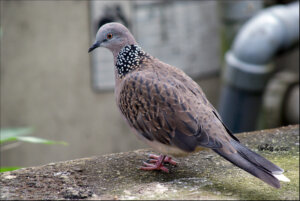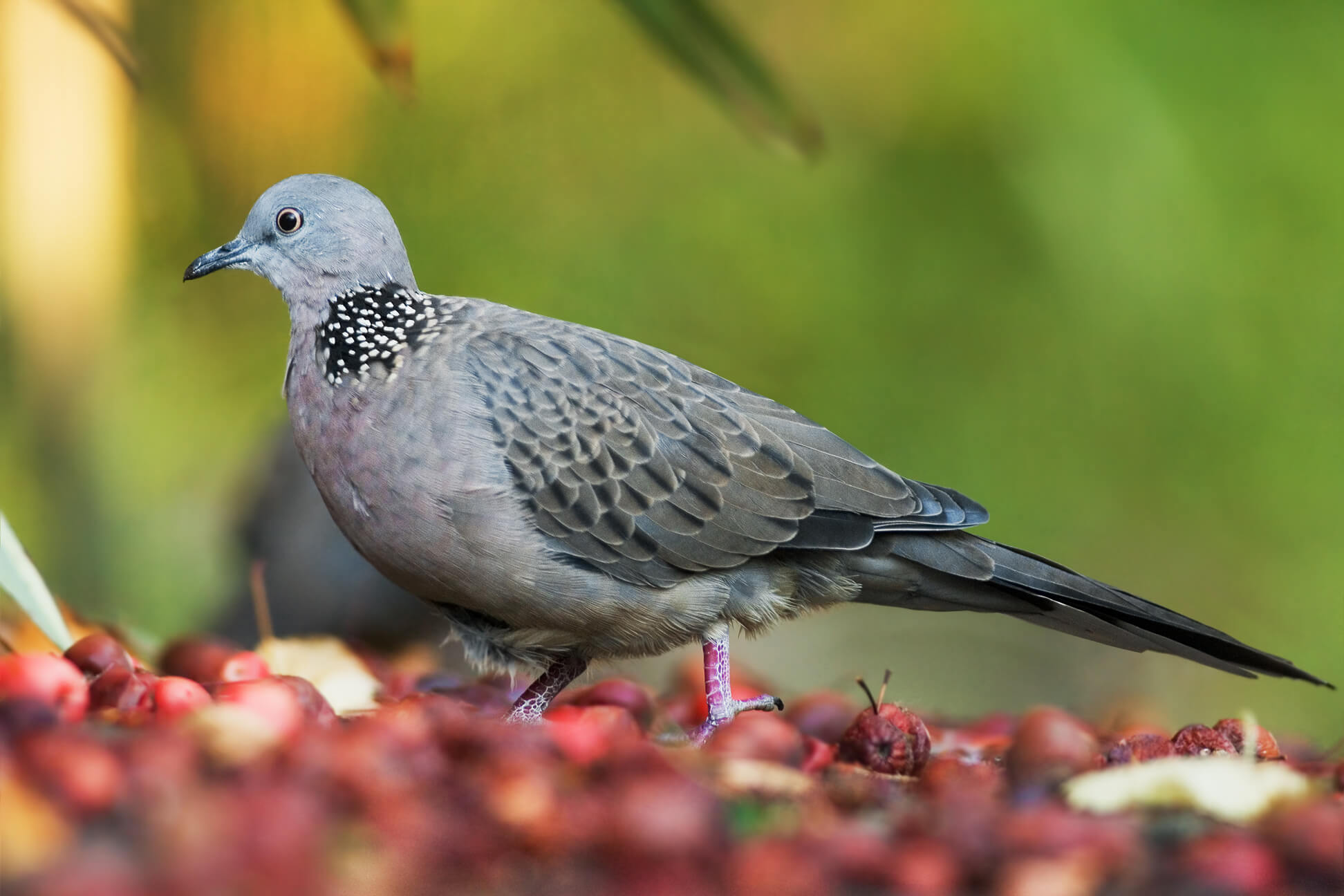Spotted Dove: Habitat, Characteristics and Curiosities


Written and verified by the biologist Cesar Paul Gonzalez Gonzalez
The spotted dove is a fairly common bird that lives near urban and suburban areas. It’s highly adaptable, which is why it’s classified as an invasive species in several countries. In fact, in Australia, it’s considered a serious threat to the ecosystem.
Formally, the scientific name of this bird is Streptopelia chinensis, and it belongs to the Columbidae family. This group includes various pigeons, turtledoves, and other similar species. Continue reading to find out all about the spotted dove.
Habitat of the spotted dove
The Chinese turtledove is naturally distributed in Asia and India. It prefers to live in forests and jungles, although any place with a little vegetation is sufficient for it. It usually frequents more humid areas where there’s a large amount of food. However, it may choose to settle in urban or rural areas to make foraging less difficult.
This bird has little dependence on its habitat, so it’s able to adapt to different environments. For this reason, when introduced in other countries, it has become a pest and has caused different ecological problems. Africa, the United States, Mexico, and Australia are some of the places that have been affected by this species.
Physical characteristics of the species
The spotted dove is a medium-sized bird that measures no more than 30 centimeters (12 inches) in length and weighs around 140 grams (nearly 6 oz). It exhibits a black-colored bill, reddish legs, and amber eyes. Likewise, its head has a light gray coloration and its chest has pink tones, while its back and wings have brown colors.
This species is known as the spotted dove because of the presence of different spots on its neck, head, and back. In addition, its tail plumage is dark on the back, but underneath has some black and white feathers.
The behavior of the species
The spotted dove is a species that’s characterized by being solitary or living in pairs. However, they can form large groups if they find enough food nearby. They don’t fly long distances, but can move quickly from one point to another.
Spotted doves are very competitive birds for resources, so they could be aggressive with other birds endemic to the area. This is one of the reasons why there are so many of them in some cities, and you can’t see any other species of birds in the vicinity.
The diet of the spotted dove is based on different types of seeds, grains, fruits and some insects occasionally. They usually go down to the ground and forage in the grass. However, in urban environments, they gather in crowded places, such as parks, to eat food scraps that fall to the ground.

Reproduction
The spotted dove is a monogamous species that chooses a mate for life. This process takes place after a flight display, in which males fly at steep angles to show off their plumage. If the female accepts him, they begin to search for a suitable place where they can build their nest.
Courtship and mate choice occurs mainly during the summer. However, the wide distribution of the species has caused changes in its reproductive process. Consequently, in some countries, they’re able to breed at any time of the year.
Nest building and parental care are shared between both parents. In nature, it’s normal to find their nests on the ground or near grass, but, in urban environments, they choose to occupy higher areas, such as the corners of buildings or houses.
Once the female lays her eggs, they hatch about 13 days later. The young take about 15 days to fully develop, and so, by day 16, several of them are able to fly and leave the nest.
Curiosities of the spotted dove
Although it may seem like a common and unattractive bird, the spotted dove might impress you. Among the most striking facts are the following:
- They abandon their young after they’re 6 days old: Before that, they feed them with a lot of food so that they can cope until they can fly.
- The female takes a little more care of the young: Even though both sexes share the parental work, the female is usually a little more careful and spends more time with the young than the male.
- They can hybridize with other turtledoves and pigeons: Being quite close, it’s normal for the spotted dove to be able to breed with other species of the Columbidae family.
- Some people use them for “singing contests “: On the island of Java (Indonesia), they’re often trained to develop a soft and melodious song.
As you may realize, the spotted dove is a rather peculiar species that’s able to live in a wide variety of places. However, it’s this very characteristic that makes it dangerous, as its ability to adapt could wreak havoc on the ecosystem. For this reason, some countries have adopted policies to control it. Although sad, this is necessary to protect endemic flora and fauna from invasion.
The spotted dove is a fairly common bird that lives near urban and suburban areas. It’s highly adaptable, which is why it’s classified as an invasive species in several countries. In fact, in Australia, it’s considered a serious threat to the ecosystem.
Formally, the scientific name of this bird is Streptopelia chinensis, and it belongs to the Columbidae family. This group includes various pigeons, turtledoves, and other similar species. Continue reading to find out all about the spotted dove.
Habitat of the spotted dove
The Chinese turtledove is naturally distributed in Asia and India. It prefers to live in forests and jungles, although any place with a little vegetation is sufficient for it. It usually frequents more humid areas where there’s a large amount of food. However, it may choose to settle in urban or rural areas to make foraging less difficult.
This bird has little dependence on its habitat, so it’s able to adapt to different environments. For this reason, when introduced in other countries, it has become a pest and has caused different ecological problems. Africa, the United States, Mexico, and Australia are some of the places that have been affected by this species.
Physical characteristics of the species
The spotted dove is a medium-sized bird that measures no more than 30 centimeters (12 inches) in length and weighs around 140 grams (nearly 6 oz). It exhibits a black-colored bill, reddish legs, and amber eyes. Likewise, its head has a light gray coloration and its chest has pink tones, while its back and wings have brown colors.
This species is known as the spotted dove because of the presence of different spots on its neck, head, and back. In addition, its tail plumage is dark on the back, but underneath has some black and white feathers.
The behavior of the species
The spotted dove is a species that’s characterized by being solitary or living in pairs. However, they can form large groups if they find enough food nearby. They don’t fly long distances, but can move quickly from one point to another.
Spotted doves are very competitive birds for resources, so they could be aggressive with other birds endemic to the area. This is one of the reasons why there are so many of them in some cities, and you can’t see any other species of birds in the vicinity.
The diet of the spotted dove is based on different types of seeds, grains, fruits and some insects occasionally. They usually go down to the ground and forage in the grass. However, in urban environments, they gather in crowded places, such as parks, to eat food scraps that fall to the ground.

Reproduction
The spotted dove is a monogamous species that chooses a mate for life. This process takes place after a flight display, in which males fly at steep angles to show off their plumage. If the female accepts him, they begin to search for a suitable place where they can build their nest.
Courtship and mate choice occurs mainly during the summer. However, the wide distribution of the species has caused changes in its reproductive process. Consequently, in some countries, they’re able to breed at any time of the year.
Nest building and parental care are shared between both parents. In nature, it’s normal to find their nests on the ground or near grass, but, in urban environments, they choose to occupy higher areas, such as the corners of buildings or houses.
Once the female lays her eggs, they hatch about 13 days later. The young take about 15 days to fully develop, and so, by day 16, several of them are able to fly and leave the nest.
Curiosities of the spotted dove
Although it may seem like a common and unattractive bird, the spotted dove might impress you. Among the most striking facts are the following:
- They abandon their young after they’re 6 days old: Before that, they feed them with a lot of food so that they can cope until they can fly.
- The female takes a little more care of the young: Even though both sexes share the parental work, the female is usually a little more careful and spends more time with the young than the male.
- They can hybridize with other turtledoves and pigeons: Being quite close, it’s normal for the spotted dove to be able to breed with other species of the Columbidae family.
- Some people use them for “singing contests “: On the island of Java (Indonesia), they’re often trained to develop a soft and melodious song.
As you may realize, the spotted dove is a rather peculiar species that’s able to live in a wide variety of places. However, it’s this very characteristic that makes it dangerous, as its ability to adapt could wreak havoc on the ecosystem. For this reason, some countries have adopted policies to control it. Although sad, this is necessary to protect endemic flora and fauna from invasion.
All cited sources were thoroughly reviewed by our team to ensure their quality, reliability, currency, and validity. The bibliography of this article was considered reliable and of academic or scientific accuracy.
- Saxena, V. L., Pandey, E., Agarwal, S., & Saxena, A. K. (2008). Execution of breeding and nidification behaviour in pigeon (Columba livia) and dove (Streptopelia chinensis). Asian J. Exp. Sci, 22(3), 405-410.
- Rajashekara, S., & Rajashekara, M. G. On the breeding of Spotted Dove Streptopelia chinensis. Recuperado el 23 de junio de 2022, disponible en: researchgate.net/profile/S-Rajashekara/publication/302963085_On_the_breeding_of_Spotted_Dove_Streptopelia_chinensis/links/5765120008ae1658e2f1e6c3/On-the-breeding-of-Spotted-Dove-Streptopelia-chinensis.pdf
- Saiya, Halvina & Verboom, Willem. (2018). Indonesian bird vocalizations: the Spotted dove (Streptopelia chinensis tigrina). 10.13140/RG.2.2.31430.09286.
- Gómez de Silva, H., A. Oliveras de Ita y R. A. Medellín. (2005). Streptopelia chinensis. Vertebrados superiores exóticos en México: diversidad, distribución y efectos potenciales. Instituto de Ecología, Universidad Nacional Autónoma de México. Bases de datos SNIB-CONABIO. Proyecto U020. México. D.F.
This text is provided for informational purposes only and does not replace consultation with a professional. If in doubt, consult your specialist.








